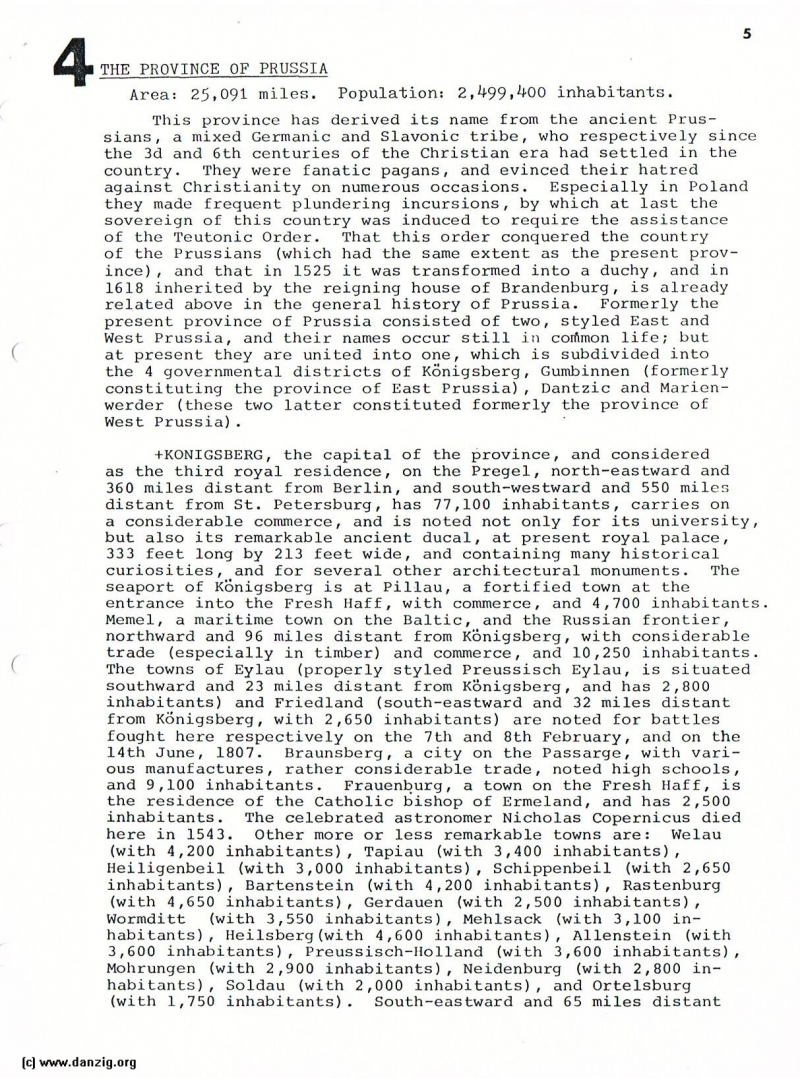
THE PROVINCE OF PRUSSIA
Area: 25,091 miles. Population: 2,499,400 inhabitants.
This province has derived its name from the ancient Prussians, a mixed Germanic and Slavonic tribe, who respectively since the 3rd and 6th centuries of the Christian era had settled in the country. They were fanatic pagans, and evinced their hatred against Christianity on numerous occasions. Especially in Poland they made frequent plundering incursions, by which at last the sovereign of this country was induced to require the assistance of the Teutonic Order. That this order conquered the country of the Prussians (which had the same extent as the present province), and that in 1525 it was transformed into a duchy, and in 1618 inherited by the reigning house of Brandenburg, is already related above in the general history of Prussia. Formerly the present province of Prussia consisted of two, styled East and West Prussia, and their names occur still in common life; but at present they are united into one, which is subdivided into the 4 governmental districts of Königsberg, Gumbinnen (formerly constituting the province of East Prussia) , Dantzic and Marienwerder (these two latter constituted formerly the province of West Prussia) .
+ KONIGSBERG, the capital of the province, and considered as the third royal residence, on the Pregel, north-eastward and 360 miles distant from Berlin, and south-westward and 550 miles distant from St. Petersburg, has 77,100 inhabitants, carries on a considerable commerce, and is noted not only for its university, but also its remarkable ancient ducal, at present royal palace, 333 feet long by 213 feet wide, and containing many historical curiosities, and for several other architectural monuments. The seaport of Knigsberg is at Pillau, a fortified town at the entrance into the Fresh Haff, with commerce, and 4,700 inhabitants. Memel, a maritime town on the Baltic, and the Russian frontier, northward and 96 miles distant from KiSnigsberg, with considerable trade (especially in timber) and commerce, and 10,250 inhabitants. The towns of Eylau (properly styled Preussisch Eylau, is situated southward and 23 miles distant from K5nigsberg, and has 2,800 inhabitants) and Friedland (south-eastward and 32 miles distant from K6nigsberg, with 2,650 inhabitants) are noted for battles fought here respectively on the 7th and 8th February, and on the 14th June, 1807. Braunsberg, a city on the Passarge, with various manufactures, rather considerable trade, noted high schools, and 9,100 inhabitants. Frauenburq, a town on the Fresh Haff, is the residence of the Catholic bishop of Ermeland, and has 2,500 inhabitants. The celebrated astronomer Nicholas Copernicus died here in 1543. Other more or less remarkable towns are: Welau (with 4,200 inhabitants), Tapiau (with 3,400 inhabitants), Heiligenbeil (with 3,000 inhabitants) , Schippenbeil (with 2,650 inhabitants), Bartenstein (with 4,200 inhabitants), Rastenburg (with 4,650 inhabitants), Gerdauen (with 2,500 inhabitants), Wormditt (with 3,550 inhabitants), Mehlsack (with 3,100 in habitants), Heilsberg(with 4,600 inhabitants), Allenstein (with 3,600 inhabitants) , Preussisch-Holland (with 3,600 inhabitants) , Mohrungen (with 2,900 inhabitants), Neidenburg (with 2,800 in habitants), Soldau (with 2,000 inhabitants) , and Ortelsburg (with 1,750 inhabitants). South-eastward and 65 miles distant
Danzig Report Nr. 17 – 1st Quarter 1978, Page 5.
Hits: 1701
Added: 06/06/2015
Copyright: 2024 Danzig.org

